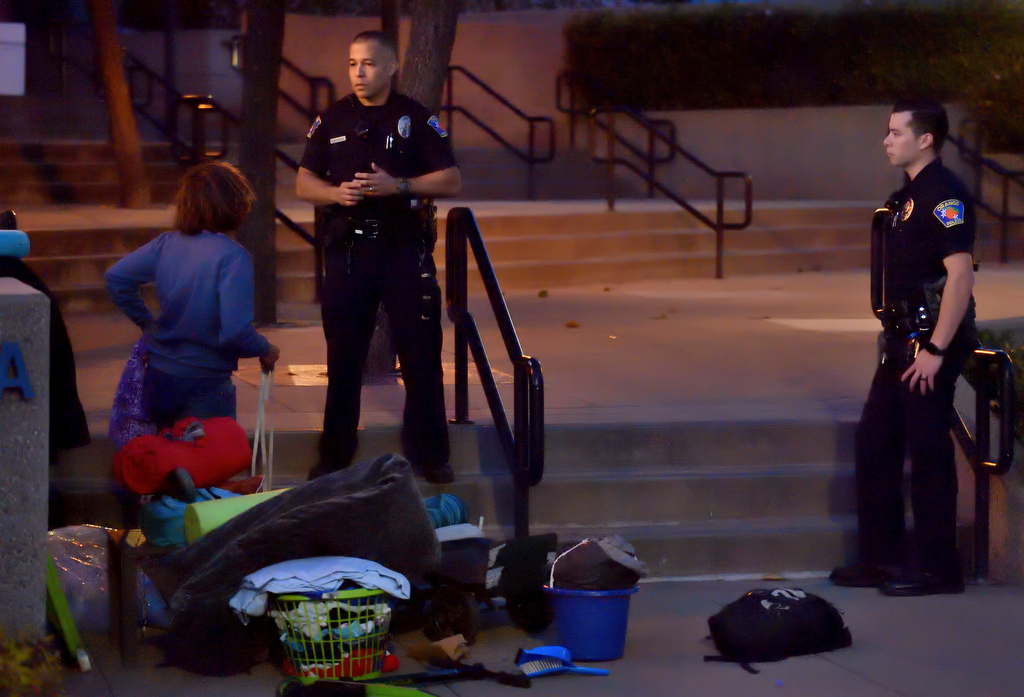Looking back on 2018, here are some of the significant issues and events that made headlines, as well as speculation on what might be in store for the coming year for first responders.

Orange County Sheriff’s Department Deputies from left, Lisa Dolan, Davida Tidwell, and Kevin Archambault enter the building at the start of an active shooter drill at Artemis Defense Institute in Lake Forest.
File photo by Steven Georges/Behind the Badge
Mass Shootings
The trend of mass shootings continued in 2018. The Borderline Bar and Grill, the Tree of Life Synagogue, T & T Trucking Company, the Capital Gazette, Santa Fe High School, Waffle House, and Stoneman Douglas High School were just some of the shootings that made news headlines. During each of these tragedies the response from law enforcement was quick and effective at stopping the threat. However, it’s never quick enough when someone is intent on doing harm.
Billions of dollars have been invested over the past decade in developing responses to terrorism, but it seems the biggest threats we face are home grown. FBI research into the minds of mass shooters demonstrates one thing: Most mass shooters don’t just snap; they plan, prepare, and exhibit behavior that causes concern in those around them. Only a quarter of the mass shooters had been diagnosed with mental illness.
I have no doubt that more mass shootings will occur in 2019. Our best defense is when we see something, to say something and allow law enforcement to try and intervene early. It’s not a cure all by any means, but every bit helps.

With help from Orange Police Officer Jordan Uemura, right, Officer Eric Velazquez talks to a homeless women in front of the police station after a dispute with a man that got physical when she said she was hit.
File photo by Steven Georges/Behind the Badge
Homelessness
The year began with the removal of the largest homeless encampment Orange County had ever seen. Over a thousand people had taken up residence along a well-used recreational path in the shadow of Anaheim Stadium, which resulted in community outrage. Efforts to enforce existing laws were often met with pushback from advocates, stifling police efforts to maintain order. Law enforcement agencies were caught in the middle.
In January 2018, the evictions and relocation of the residents began. The story made national headlines and came at a great financial cost to the county and cities impacted.
Thus far, in 2018, Orange County has allocated 189 million dollars to homeless-related programming. This doesn’t include the amount being allocated by cities and their efforts, nor the reassignment of police officers from other jobs to deal with homeless issues.
Homeless behavior is a national problem facing almost every city in America. Despite the pouring-in of millions of dollars and innovative strategies there is no one thing that works. The problems are way too complex for simple solutions.
For first responders, homeless behavior is the problem. Crimes against other homeless people, drug use, theft, and severe mental illness are what put the homeless on the police radar. Medical issues and even brush fires started by homeless camps create problems for fire departments. Then there are the complaints from community members demanding a response. Pushback from communities uncomfortable with the visible presence of homeless populations will continue to make homeless issues a challenge for police departments in 2019.

La Habra Police Department’s new body camera, the Axon Body 2, worn by one of its officers.
File photo by Steven Georges/Behind the Badge
Body Cameras
The boon in the usage of body cameras has been an effective aid in demonstrating police transparency and police accountability. Beginning in mid 2019, California police agencies will have 45 days to make most body camera footage of shootings and significant use of force available to the public.
The challenge will be explaining justifiable use of force to a public that has Hollywood perceptions of what use of force should look like. Most people have never been in a physical altercation, used a handgun, or even played a contact sport. There is no easy way to put handcuffs on someone when they don’t want handcuffs placed on them. How do we educate the public about the realities of police work?
Departments will be most challenged by the narrative that accompanies the release of camera footage. In circumstances where there is police malpractice and poor judgment on the part of the officers, departments will have to be honest and deal with the consequences.

Recruit applicants gather at 7 a.m. for a police academy agility test given by the Tustin Police Department at Tustin Sports Park.
File photo by Steven Georges/Behind the Badge
Recruitment
Recruiting police officers is nearing crisis levels for many agencies. Testing, interviewing, and putting applicants through background checks takes time. The public expects this level of scrutiny and departments have a responsibility to manage risk by hiring the best possible applicants. The negative portrayal of police over the last few years, a good economy, and high standards have made recruitment a significant challenge.
The pressure is on for agencies to lower their standards in order to get more applicants through the process. Previous drug use, commission of minor crimes, and moral shortcomings are all areas where agencies have made compromises. This is a path filled with long-term risk.
Agencies faced similar pressures and lowered their standards in the 1980s. The result was corruption, criminal behavior, and rampant misconduct years down the road.

Fire burns toward the Incident Command Post during the initial attack of the Canyon Fire 1. Photo by Anaheim P0lice Department Sgt. Daron Wyatt
Natural Disasters
The Camp Fire, the Woosley Fire, and the Holy Jim Fire were just some of the fires that struck California during 2018. Tens of thousands of families were impacted, and first responders were challenged to keep up. California utilized resources from throughout the country this fire season. The scary thing is, according to some, this may be the new normal given the effects of climate change and other environmental factors.
 Behind the Badge
Behind the Badge



